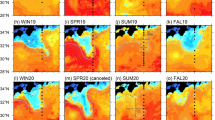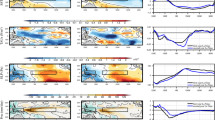Abstract
An analysis of a 68-year monthly hindcast output from an eddy-resolving ocean general circulation model reveals the relationship between the interannual variability of the Kerama Gap transport (KGT) and the Kuroshio/Ryukyu Current system. The study found a significant difference in the interannual variability of the upstream and downstream transports of the East China Sea- (ECS-) Kuroshio and the Ryukyu Current. The interannual variability of the KGT was found to be of paramount importance in causing the differences between the upstream and downstream ECS-Kuroshio. Additionally, it contributed approximately 37% to the variability of the Ryukyu Current. The interannual variability of the KGT was well described by a two-layer rotating hydraulic theory. It was dominated by its subsurface-intensified flow core, and the upper layer transport made a weaker negative contribution to the total KGT. The subsurface flow core was found to be mainly driven by the subsurface pressure head across the Kerama Gap, and the pressure head was further dominated by the subsurface density anomalies on the Pacific side. These density anomalies could be traced back to the eastern open ocean, and their propagation speed was estimated to be about 7.4 km/d, which is consistent with the speed of the local first-order baroclinic Rossby wave. When the negative (positive) density anomaly signal reached the southern region of the Kerama Gap, it triggered the increase (decrease) of the KGT towards the Pacific side and the formation of an anticyclonic (cyclonic) vortex by baroclinic adjustment. Meanwhile, there is an increase (decrease) in the upstream transport of the entire Kuroshio/Ryukyu Current system and an offshore flow that decreases (increases) the downstream Ryukyu Current.
Similar content being viewed by others
References
Andres M, Park J H, Wimbush M, et al. 2008. Study of the Kuroshio/Ryukyu Current system based on satellite-altimeter and in situ measurements. Journal of Oceanography, 64(6): 937–950, doi: https://doi.org/10.1007/s10872-008-0077-2
Chelton D B, deSzoeke R A, Schlax M G, et al. 1998. Geographical variability of the first baroclinic Rossby radius of deformation. Journal of Physical Oceanography, 28(3): 433–460, doi: https://doi.org/10.1175/1520-0485(1998)028<0433:GVOTFB>2.0.CO;2
Gao Jie, Guo Xinyu, Yoshie N, et al. 2022. Occurrence of surface phytoplankton bloom as the Kuroshio Current passes an island. Journal of Geophysical Research: Oceans, 127(9): e2021JC018242, doi: https://doi.org/10.1029/2021JC018242
Garrett C, Toulany B. 1982. Sea level variability due to meteorological forcing in the northeast Gulf of St. Lawrence. Journal of Geophysical Research: Oceans, 87(C3): 1968–1978, doi: https://doi.org/10.1029/JC087iC03p01968
Guo Xinyu, Zhu Xiaohua, Wu Qingsong, et al. 2012. The Kuroshio nutrient stream and its temporal variation in the East China Sea. Journal of Geophysical Research: Oceans, 117(C1): C01026
Hsin Y C, Qiu Bo, Chiang T L, et al. 2013. Seasonal to interannual variations in the intensity and central position of the surface Kuroshio east of Taiwan. Journal of Geophysical Research: Oceans, 118(9): 4305–4316, doi: https://doi.org/10.1002/jgrc.20323
Ichikawa H, Nakamura H, Nishina A, et al. 2004. Variability of northeastward current southeast of northern Ryukyu Islands. Journal of Oceanography, 60(2): 351–363, doi: https://doi.org/10.1023/B:JOCE.0000038341.27622.73
Jin Baogang, Wang Guihua, Liu Yonggang, et al. 2010. Interaction between the East China Sea Kuroshio and the Ryukyu Current as revealed by the self-organizing map. Journal of Geophysical Research: Oceans, 115(C12): C12047
Liu Zhaojun, Zhu Xiaohua, Wang Min, et al. 2020. Variability of the deep overflow through the Kerama Gap revealed by observational data and global ocean reanalysis. Journal of Marine Science and Engineering, 8(6): 402, doi: https://doi.org/10.3390/jmse8060402
Na Hanna, Wimbush M, Park J H, et al. 2014. Observations of flow variability through the Kerama Gap between the East China Sea and the Northwestern Pacific. Journal of Geophysical Research: Oceans, 119(2): 689–703, doi: https://doi.org/10.1002/2013JC008899
Nakamura H, Ichikawa H, Nishina A. 2007. Numerical study of the dynamics of the Ryukyu Current system. Journal of Geophysical Research: Oceans, 112(C4): C04016
Nakamura H, Nishina A, Liu Zhaojun, et al. 2013. Intermediate and deep water formation in the Okinawa Trough. Journal of Geophysical Research: Oceans, 118(12): 6881–6893, doi: https://doi.org/10.1002/2013JC009326
Nishina A, Nakamura H, Park J H, et al. 2016. Deep ventilation in the Okinawa Trough induced by Kerama Gap overflow. Journal of Geophysical Research: Oceans, 121(8): 6092–6102, doi: https://doi.org/10.1002/2016JC011822
Qiu Bo, Chen Shuiming. 2010. Interannual to decadal variability in the bifurcation of the North Equatorial Current off the Philippines. Journal of Physical Oceanography, 40(11): 2525–2538, doi: https://doi.org/10.1175/2010JPO4462.1
Qu Tangdong, Girton J B, Whitehead J A. 2006. Deepwater overflow through Luzon Strait. Journal of Geophysical Research: Oceans, 111(C1): C01002
Qu Tangdong, Song Y T. 2009. Mindoro Strait and Sibutu Passage transports estimated from satellite data. Geophysical Research Letters, 36(9): L09601
Ram VSS, Kayastha N, Sha Kewei. 2022. OFES: optimal feature evaluation and selection for multi-class classification. Data & Knowledge Engineering, 139: 102007
Sasaki H, Sasai Y, Kawahara S, et al. 2004. A series of eddy-resolving ocean simulations in the world ocean-OFES (OGCM for the Earth Simulator) project. In: Oceans’ 04 MTS/IEEE Techno-Ocean’ 04 (IEEE Cat. No. 04CH37600). Kobe, Japan: IEEE, 1535–1541
Soeyanto E, Guo Xinyu, Ono J, et al. 2014. Interannual variations of Kuroshio transport in the East China Sea and its relation to the Pacific Decadal Oscillation and mesoscale eddies. Journal of Geophysical Research: Oceans, 119(6): 3595–3616, doi: https://doi.org/10.1002/2013JC009529
Song Y T. 2006. Estimation of interbasin transport using ocean bottom pressure: theory and model for Asian marginal seas. Journal of Geophysical Research, 111(C11): C11S19
Susanto R D, Song Y T. 2015. Indonesian throughflow proxy from satellite altimeters and gravimeters. Journal of Geophysical Research: Oceans, 120(4): 2844–2855, doi: https://doi.org/10.1002/2014JC010382
Thoppil P G, Metzger E J, Hurlburt H E, et al. 2016. The current system east of the Ryukyu Islands as revealed by a global ocean reanalysis. Progress in Oceanography, 141: 239–258, doi: https://doi.org/10.1016/j.pocean.2015.12.013
Wang Youlin, Wu Chau-Ron. 2018. Discordant multi-decadal trend in the intensity of the Kuroshio along its path during 1993–2013. Scientific Reports, 8(1): 14633, doi: https://doi.org/10.1038/s41598-018-32843-y
Whitehead J A, Leetmaa A, Knox R A. 1974. Rotating hydraulics of strait and sill flows. Geophysical Fluid Dynamics, 6(2): 101–125, doi: https://doi.org/10.1080/03091927409365790
Xu Lixiao, Li Peiliang, Xie Shangping, et al. 2016. Observing mesoscale eddy effects on mode-water subduction and transport in the North Pacific. Nature Communications, 7: 10505, doi: https://doi.org/10.1038/ncomms10505
Xu Lixiao, Xie Shangping, McClean J L, et al. 2014. Mesoscale eddy effects on the subduction of North Pacific mode waters. Journal of Geophysical Research: Oceans, 119(8): 4867–4886, doi: https://doi.org/10.1002/2014JC009861
Yu Zhitao, Metzger E J, Hurlburt H E, et al. 2019. What controls the extreme flow through the Kerama Gap: a global HYbrid coordinate ocean model reanalysis point of view. Ocean Dynamics, 69(8): 899–911, doi: https://doi.org/10.1007/s10236-019-01284-0
Yu Zhitao, Metzger E J, Thoppil P, et al. 2015. Seasonal cycle of volume transport through Kerama Gap revealed by a 20-year global HYbrid coordinate ocean model reanalysis. Ocean Modelling, 96: 203–213, doi: https://doi.org/10.1016/j.ocemod.2015.10.012
Yuan Yaochu, Kaneko A, Su Jilan, et al. 1998. The Kuroshio east of Taiwan and in the East China Sea and the currents east of Ryukyu Islands during early summer of 1996. Journal of Oceanography, 54(3): 217–226, doi: https://doi.org/10.1007/BF02751697
Zhao Ruixiang, Nakamura H, Zhu Xiaohua, et al. 2020. Tempo-spatial variations of the Ryukyu Current southeast of Miyakojima Island determined from mooring observations. Scientific Reports, 10(1): 6656, doi: https://doi.org/10.1038/s41598-020-63836-5
Zhou Wenzheng, Yu Fei, Nan Feng. 2017. Water exchange through the Kerama Gap estimated with a 25-year Pacific hybrid coordinate ocean model. Chinese Journal of Oceanology and Limnology, 35(6): 1287–1302, doi: https://doi.org/10.1007/s00343-017-6141-2
Zhou Wenzheng, Yu Fei, Nan Feng, et al. 2018. Effects of mesoscale eddies on the variation of water exchange through the Kerama Gap. Journal of Oceanography, 74(3): 263–275, doi: https://doi.org/10.1007/s10872-017-0456-7
Zhu Xiaohua, Han In-Seong, Park J H, et al. 2003. The northeastward current southeast of Okinawa Island observed during November 2000 to August 2001. Geophysical Research Letters, 30(2): 1071
Zhu Xiaohua, Huang Daji, Guo Xinyu. 2010. Autumn intensification of the Ryukyu Current during 2003–2007. Science China Earth Sciences, 53(4): 603–609, doi: https://doi.org/10.1007/s11430-010-0022-2
Acknowledgements
All data and tools underlying this analysis are openly available: Japan Agency for Marine-Earth Science and Technology (JAMSTEC) Ocean General Circulation Model for the Earth Simulator (OFES) dataset (https://www.jamstec.go.jp/ofes/). AVISO satellite altimeter data is available from https://www.aviso.altimetry.fr/en/home.html. The WOA data is downloaded from Asia-Pacific Data-Research Center (APDRC) (http://apdrc.soest.hawaii.edu/).
Author information
Authors and Affiliations
Corresponding author
Additional information
Foundation item: The Fundamental Research Funds for the Central Universities under contract No. B220201024.
Rights and permissions
About this article
Cite this article
Zhou, H., Yu, K., Qin, J. et al. Study on the interannual variability of the Kerama Gap transport and its relation to the Kuroshio/Ryukyu Current system. Acta Oceanol. Sin. 43, 1–14 (2024). https://doi.org/10.1007/s13131-023-2281-8
Received:
Accepted:
Published:
Issue Date:
DOI: https://doi.org/10.1007/s13131-023-2281-8




